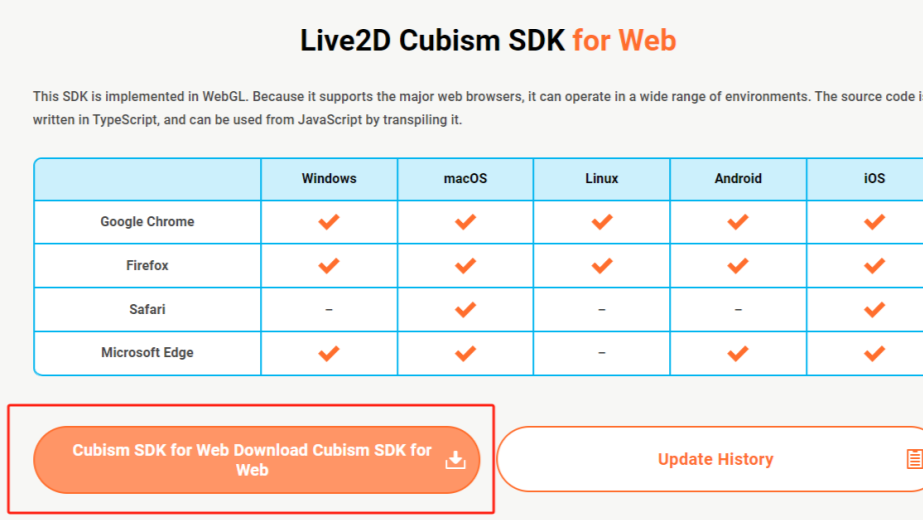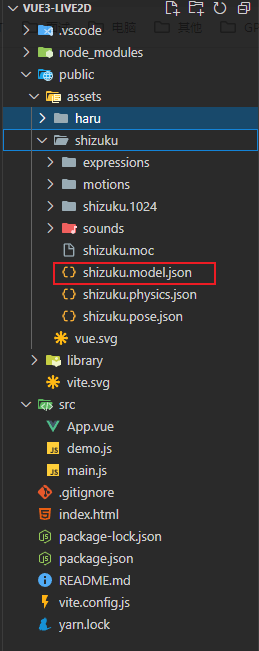Appearance
前端 Vue3+Live2d 开发虚拟人物应用
1. 所需技术栈
Vue3+ts
Live2D官方SDK
pixi.js@6.x pixi-live2d-display 两个库
个人考虑到离线使用的情况,可以不安装依赖,直接引入本地的JS文件,参考: https://github.com/1zBin/vue3-live2d.git
2. Live2D官方SDK
下载地址:https://www.live2d.com/en/sdk/about/ (需翻墙)
前端SDK需对应web选项

下载文件:

下载解压后将CubismSdkForWeb-4/Core/live2dcubismcore.min.js此文件复制到public/library文件夹中
并在index.html中引用
3. 引用两个库
npm install pixi.js@6.4.2
npm install pixi-live2d-display4. 准备好live2d资源
一般设计师会给到一个文件夹,里面包含了一堆json,里面的.model3.json是live2d模型的入口文件。把这个文件夹放到项目的public目录,因为打包后它会出现在dist/下,到时候需要能够引用到。(ps:实在迷茫的小伙伴可以去B站买一个live2D有一分钱的)

5. 代码层面
在template标签中定义canvas标签
<template>
<div>
<canvas ref="canvas"></canvas>
</div>
</template>Script标签中引用vue方法和相应文件,定义变量
Typescript
<script setup lang="ts">
import { onBeforeUnmount, onMounted, ref } from "vue";
import * as PIXI from "pixi.js";
import { Live2DModel } from "pixi-live2d-display/cubism4";
(window as any).PIXI = PIXI;
let app:PIXI.Application;
let model:any;
const canvas = ref(null);
......获取live2d模型调用PIXI.js在页面进行渲染,我这里加了按住模型拖拽功能,可用可不用。
Typescript
const live2d = PIXI.live2d;
onMounted(async () => {
app = new PIXI.Application({
view: canvas.value,
// height: 500,
// width: 500,
autoDensity: true,
antialias: true,
resolution: window.devicePixelRatio,
autoStart: true,
resizeTo: window,
transparent: true,
});
model = await live2d.Live2DModel.from("assets/shizuku/shizuku.model.json");
app.stage.addChild(model);
const scaleX = (innerWidth * 0.2) / model.width;
const scaleY = (innerHeight * 0.4) / model.height;
// fit the window
model.scale.set(Math.min(scaleX, scaleY));
model.x = innerWidth * 0.82;
model.y = innerHeight * 0.6;
draggable(model);
addFrame(model);
model.on("hit", (hitAreas) => {
console.log("hitAreas", hitAreas);
if (hitAreas.includes("body")) {
model.motion("tap_body");
}
if (hitAreas.includes("head")) {
model.expression();
}
});
});
function draggable(model) {
model.buttonMode = true;
model.on("pointerdown", (e) => {
model.dragging = true;
model._pointerX = e.data.global.x - model.x;
model._pointerY = e.data.global.y - model.y;
});
model.on("pointermove", (e) => {
if (model.dragging) {
model.position.x = e.data.global.x - model._pointerX;
model.position.y = e.data.global.y - model._pointerY;
}
});
model.on("pointerupoutside", () => (model.dragging = false));
model.on("pointerup", () => (model.dragging = false));
}
function addFrame(model) {
const foreground = PIXI.Sprite.from(PIXI.Texture.WHITE);
foreground.width = model.internalModel.width;
foreground.height = model.internalModel.height;
foreground.alpha = 0.2;
model.addChild(foreground);
}
onBeforeUnmount(() => {
model?.destroy();
app?.destroy();
});
</script>关于PIXI.js的方法可以参考相关博客: https://www.cnblogs.com/huangqian/p/17626223.html
6. 启动项目
npm启动你的vue3项目就可以看到成果了

7. 进阶:Live2d模型动作&表情
Live2d模型动作&表情请看下一篇“vue3+live2d+electron 开发桌面宠物应用程式”